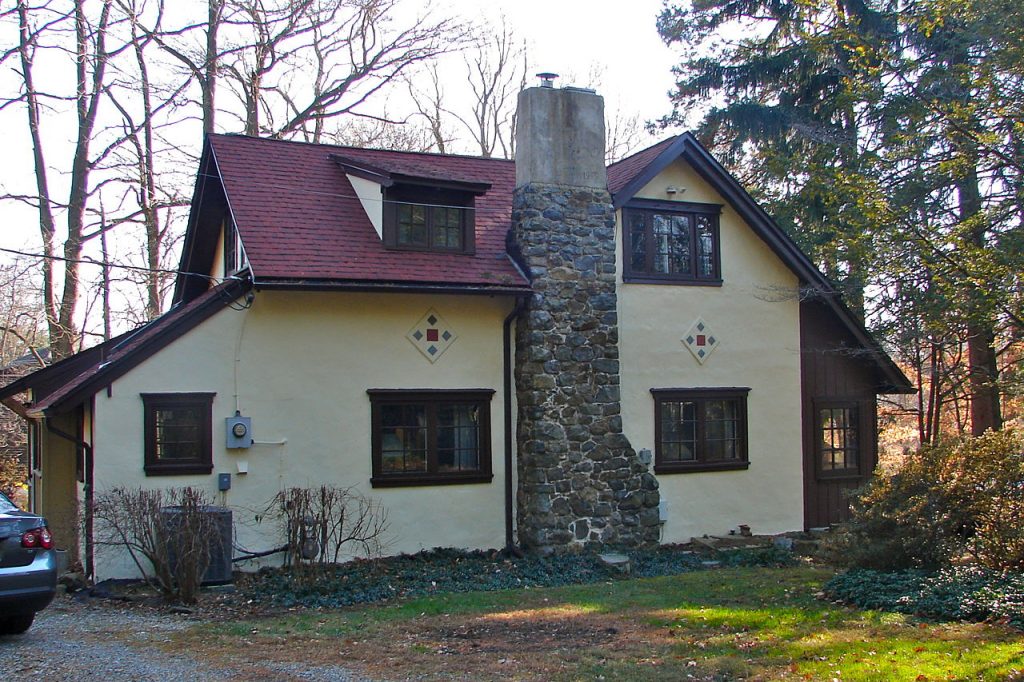The Ardens’ social, architectural, and political aims can seem very serious, but Ardenfolk also had their share of fun—and so did their architecture along with it! Even Arden’s name comes from the forest in Shakespeare’s As You Like It where “a many merry men…live like the old Robin Hood of England…and fleet time carelessly as they did in the gold world” (Act 1.1.112-115).

The cast of “Julius Caesar” poses for a photograph
Theater, complete with costuming, was an important component of life in Arden. Houses, buildings, and the woods were given fanciful names, like Admiral Benbow (after the Inn of the same name in Treasure Island), the Friendly Gables, Sherwood Forest, and Robin Hood Theatre.
Amid Arden’s simple, unassuming architectural designs, mottos and plaques are scattered to remind residents of what matters in life. The Founders House includes the motto “Tomorrow is a New Day” at the front, and the Green Gate includes a gilded inscription reading “La Vera Vin Liberigo,” or “the good wine liberates.” Additionally, decorative designs and arts created by Ardenfolk punctuate Arden houses.

A closer view of Green Gate, featuring Price’s decorative tile

Decorative tile in Rose Valley. Photograph by Katheryn Lawson
Green Gate’s stucco exterior includes decorative tilework that is distinctive of Price’s other community, Rose Valley; in fact, it is the only house in Arden with such tilework. Its interior, too, is not without whimsy. Along with its inscription that “good wine liberates,” Green Gate boasts a pastoral mural painted by then 16-year-old resident Buzz Ware.

Buzz Ware’s mural in Green Gate
These are only a few details that illustrate Arden’s success as a community, political, economical, and, above all, whimsical.
RELATED SOURCES:
Arden Community Planning Committee. The Arden Book. 4th ed. Arden, DE: Village of Arden, 1999.
Cherry, John. Introduction. In William Morris: Art and Kelmscott, ed. Linda Parry, vii. Suffolk: Boydell Press, 1996.
Edwards, Eliza Harvey. “Arden: The Architecture and Planning of a Delaware Utopia.” Master’s Thesis, University of Pennsylvania, 1993.
Edwards, Robert. “William Lightfoot Price: His Furniture and Its Context.” In American Furniture, ed. Luke Beckerdite, 116–153. Lebanon, NH: The Chipstone Foundation, 2012.
Harvey, Charles and Jon Press. “The Business Career of William Morris.” In William Morris: Art and Kelmscott, ed. Linda Parry, 3–22. Suffolk: Boydell Press, 1996.
Massey, James C. and Shirley Maxwell. “Artful Living.” Old-House Journal (October–November 2011): 58–61.
Maynard, W. Barksdale. Buildings of Delaware. Charlottesville, VA: University of Virginia Press, 2008.
Pevsner, Nikolaus. Pioneers of Modern Design: From William Morris to Walter Gropius. 4th ed. New Haven: Yale University Press, 2004.
Taylor, Mark. Arden. Images of America. Portsmouth, NH: Arcadia Publishing, 2010.
Taylor, Mark. “Utopia by Taxation: Frank Stephens and the Single Tax Community of Arden, Delaware.” The Pennsylvania Magazine of History and Biography 126, no. 2 (2002): 305–325.
Thomas, George E. William L. Price: Arts and Crafts to Modern Design. New York: Princeton Architectural Press, 2000.




